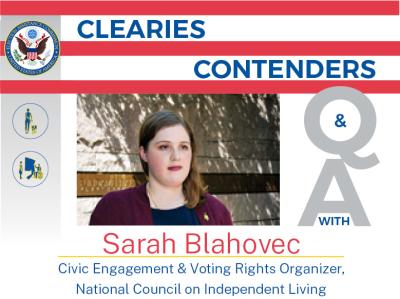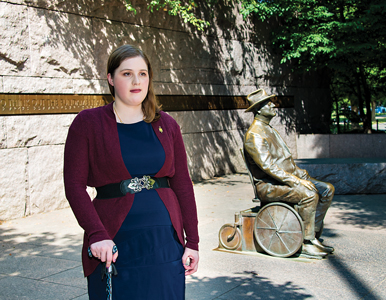
In early September, the EAC will kick off the submission period for the fourth annual 2019 Clearinghouse Awards. Dubbed the “Clearies” for short, the national effort celebrates best practices in election administration and helps advance the EAC’s clearinghouse responsibilities under the Help America Vote Act.
Over the coming weeks, we will highlight the achievements of 2018 Clearie Award(opens in new tab) entrants. Recently, I caught up with Sarah Blahovec, Civic Engagement and Voting Rights Organizer for the National Council on Independent Living (NCIL) to discuss their 2018 entry.
NCIL’s Toolkit for Disability Advocates was a 2018 Clearie contender in the category of Improving Accessibility for Voters with Disabilities. The toolkit assists election officials with website accessibility and continues to be an instrumental resource in the endeavor for equal access for voters with disabilities. Below are my questions for Sarah and her responses.
EAC: NCIL advocates for individuals with disabilities and independent living centers. Please tell us more about NCIL. How are you currently working to empower voters with disabilities?
Sarah: The National Council on Independent Living is the longest-running national cross-disability, grassroots organization run by and for people with disabilities. At NCIL, we have several goals around civic engagement for people with disabilities, including making the election process more accessible from registration through Election Day and encouraging people with disabilities to vote. We work with Centers for Independent Living to advocate for accessibility improvements in voting on the state and local level, as well as help them participate in nonpartisan Get Out The Vote (GOTV) and voter registration activities.
EAC: NCIL recently issued a toolkit to assist election officials and disability advocates entitled “Achieving Accessibility for Election Websites and Sample Ballots.” What information is found in this toolkit and how can election officials obtain a copy?
Sarah: We created this free toolkit because election websites and sample ballots are vital voter education tools and although federal law mandates website accessibility, many websites still have access barriers. We start by educating readers on what these laws require and on what the most common access barriers are. Then, we provide information and resources on how to evaluate websites for a variety of access barriers and how to begin to fix these issues. Similarly, many sample ballots are uploaded in formats that aren’t readable for people who use assistive technology, so we have a section on document accessibility. We have information for advocates on how to approach their election office to work on these and an appendix of all of the resources listed in the document. This toolkit is available for free in PDF, Word, and plain text formats.
EAC: What problems and challenges did NCIL observe that led to the creation of this resource? What are the opportunities that it offers?
Sarah: In recent years, several decisions have been made in the courts mandating the accessibility of election websites. Inaccessibility of the election process is not well researched but a 2015 report by the American Civil Liberties Union found that only one state, California, had a fully accessible online voter registration system. Most election websites are operated by local election officials (and by state governments at the statewide level) and there isn’t much being done on the federal level to ensure that these websites are accessible, so that means that accessibility is all over the place, and it is usually up to local disability advocates to approach their election officials about improving their website accessibility. If these websites are not accessible, it means that voters with disabilities cannot access vital information like deadlines or information about their polling place, and many can’t access their sample ballots to prepare to cast their vote.
This toolkit offers opportunities for both disability advocates and election officials. For disability advocates, it educates them on the common access barriers, how to evaluate them, and how to fix them so that they are armed with knowledge when they approach election officials and can actually pinpoint the problems for their local website before approaching election officials. It also gives them information on how to reach out to their local election office to start the conversation and build a working relationship to fix these issues.
For election officials, it offers them the opportunity to learn about these access barriers, evaluate them, and fix them. Accessibility isn’t a one-time fix. It’s something that they need to build into their work, and as their website changes, they need to ensure that it is not only made accessible but that it is maintained as an accessible website. They can proactively learn about access barriers and fix them so that they are in compliance with accessibility standards and so that all voters, regardless of disability, can have equal access to voting information.
EAC: Most people think of voters who are blind and visually impaired when discussing website accessibility. However, accessible websites often help many people with various types of access needs. Please expand on how voters with differing disabilities may benefit from NCIL’s toolkit.
Sarah: Accessibility is a cross-disability issue and there are a variety of access needs beyond screen reader accessibility. In fact, screen readers may be used not just by blind and low-vision users but also by people with limited mobility. People with mobility-related disabilities may also need a website to be navigable by keyboard, something that involves website design. People who are deaf or hard-of-hearing need any audio information, such as videos, captioned or including a transcript. People with cognitive disabilities, people with low literacy, or people who speak English as a second language need plain language information, and writing in plain language is a specific skill that involves making information readable easily understandable. However, our guide does not yet sufficiently address plain language, and I am planning to make revisions to include resources on plain language accessibility.
EAC: NCIL recently hosted the EAC Commissioners for a discussion about accessibility and security in the voting process. Often, enhanced website security translates into decreased accessibility for people with disabilities. In what ways can local community advocates partner with election offices to ensure compliance with accessibility laws as website changes take place?
Sarah: Local advocates can meet with election officials to discuss how they can improve the accessibility of election websites and ensure accessibility throughout the election process for voters with disabilities. Beyond that, I’ve also seen local advocates and CILs have great success with inviting their election officials into the community to connect with voters with disabilities, just as we have done with the EAC. They have held local forums at the CIL and invited both the election office and voters with disabilities to meet together and discuss election accessibility. Often, this is a great start to an amicable and working partnership between the local disability community and election office.
We would like to extend a big thank you to Sarah and NCIL for their great efforts to empower both election officials and voters with disabilities. As officials prepare for the 2020 elections, this toolkit will assist voters with disabilities in accessing the ballot. Please check back over the next few weeks as we discuss the Clearies and other innovative best practices from across the U.S. The 2019 Clearies are right around the corner and we hope you will consider submitting your initiatives so we can help celebrate your programs and promote your successes.


